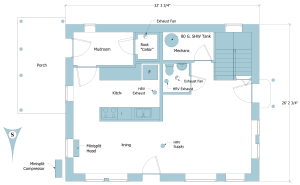Floor Plans (Click on images for larger versions)
- First floor plan. 9′ Ceilings throughout.
- Second floor plan. The bedroom at left has a ceiling height of about 7′-2″. The bedroom at right has a cathedral ceiling and a loft accessible from the the third floor room. The bathroom, hall, and closet are all cathedral ceiling.
- The third floor office space is tucked into the peak of the roof. Its north knee wall is about 4′ and its south is about 16″. The height peaks at about 7′ just above the center of the stairs.
South Wall Assembly Detail Diagram (click image for larger version)
The full CAD Plans v1.5
This version of the plans is almost exactly what was built. It includes exact plans for every wall in the house. A couple of notable differences: there is no gas fired space heater, the condenser for the heat pump is located on the south west corner of the house. Unfortunately, the PDF file is somewhat disorganized; I meant to clean it up in Archicad before I lost my student license, but alas, I never got around to it. Be aware that this is a 15mb file.
10 Charles St Final Plans.pdf (15mb)
The CAD Plans v1.0:
This is the set of plans that was submitted to the building department for review. I continued to work on them during construction. Mostly in the form of adding more information. Some key differences in this version compared to the final version:
- There is no 3rd floor loft
- There are changes in the north facing windows
- There is a gas powered space heater on the first floor instead of an air source heat pump
- The interior framing on the first floor near the bathroom and mechanical room is altered
- The laundry is on the first floor






Much to look at. I enjoy the fact that you put it all out there. I am data mining for pv design and found you. Catch you later. Look forward to talking to you in the futuere.
Great plans. Very nice house design.Is it possible to build it with basement?
One could certainly add a basement, but not without considering the implications to the passive solar design. The house is on slab which acts like a flywheel: absorbing the heat from the sun and re-releasing it during the evening (reverse the approach for the summer). Without it the house would overheat during sunny winter days and require more AC during the summer. If a full basement is going to be added to the design, one either needs to build industrial grade floor system to hold the weight, or reduce the amount of solar gain (less southern glass). I would not recommend this approach because the passive solar is a very important aspect of the house and being energy efficient (any sunny winter day provides us with enough heat to allow us to shut off our mechanical heat source and the temperature will be around 70F). If a basement is desired I would choose a hybrid approach: a basement only on the north half of the house–the area where the sun entering the windows doesn’t reach.
I wish plans with partial basement would be made available for other people to replicate well-designed energy efficient house like this. Are you planning to ask government agencies for making editable construction/build drawings of your design available to wider public use as a non – profit enterprise? It would certainly help to all those with similar vision for energy efficient housing. I certainly wish I could use your plans and repeat your success. Thank you for giving us hope. Best regards, Jim
Please note, we don’t have a partial basement. I am happy to provide the plans to whomever is interested. Unfortunately, the editable version is in Archicad, a rather expensive software program.
Did you need a structure engineer stamp on your drawing?
Only for a couple of things: Our shallow frost protected foundation (which was not covered by prescriptive codes), and the use of Typar to hold back the roof insulation from the ventilation plane (which was an unjustified requirement by the building inspector). As long as one sticks to prescriptive code, there is no need for stamps.
Pingback: Updated Plans Available | Design & Construction of Spartan & Hannah's Home